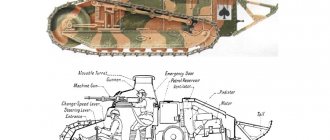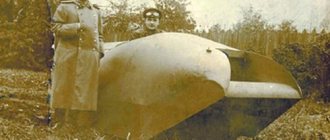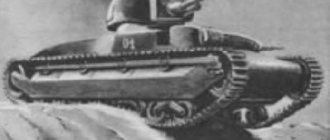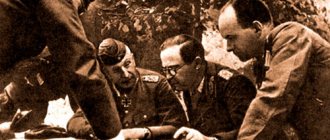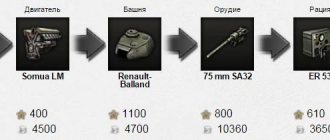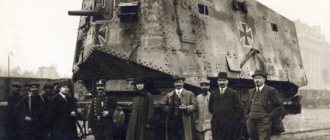This term has other meanings, see Tanker (meanings).
The crew of the T-26 tank. A group
of tankers
near the Tetrarch MkVII tank.
1942 The tank crews
can be seen wearing uniforms: pre-war overalls and helmets; the commander wears a leather jacket with full equipment over it
Tankman
- any member of the crew of a tank (combat vehicle (BM)).
Colloquially tankman
any serviceman of tank (ABTV, BTiMV, and so on) troops and the crew of a combat vehicle.
Tank crew positions[ | ]
Tank crews
differ in positions, quantity and composition depending on the type, type or model of the tank, depending on the classification of tanks as BM, in the armed forces of a particular state. For example, the crew of the main BT-7 tanks consists of three people, the T-34 - 4 people, the KV-2 - 6 people, and the special IMR tank - two people (driver and commander-operator).
The main positions of tankers in the crew are: commander, gunner, driver, loader, radio operator and machine gunner.
Tank commander[ | ]
Tank commander
directs the actions of the tank crew during combat operations, during combat training activities and maintenance of the materiel. The tank commander reports to the tank platoon commander and is the immediate superior for the tank crew members (squad). Military positions of tank commanders are filled by military personnel after training in a military training unit.
The regular position in the Russian Armed Forces is a squad leader in a tank platoon. The regular military rank is sergeant[1]. Until the 1960s, tank commanders had a higher rank: sergeant major in the 1950s, and even junior officers during the Great Patriotic War.
Order on the appointment of command staff for medium and heavy tanks No. 0400, dated October 9, 1941. To increase the combat effectiveness of tank forces and their better combat use in cooperation with other branches of the military, appoint: 1. To the positions of commanders of medium tanks - junior lieutenants and lieutenants. 2. In the position…. The Head of the Financial Directorate of the Red Army should make appropriate changes to maintenance salaries.
People's Commissar of Defense I. Stalin
- f. 4, op. 11, d. 66, l. 167. Original.
Gunner [ | ]
View of the gunner's position (bottom left) and tank commander's position (top right) in the M1 Abrams tank.
Gunner
The tank is the deputy commander of the tank. When a tank crew performs a combat mission, the gunner fires from a tank cannon and machine gun at targets specified by the tank commander or discovered independently. A special feature of the specialist’s activity is the precise aiming of the gun at the target and the firing of shots.
Full-time position in the Russian Armed Forces - gunner-operator
. The regular military rank is corporal[2].
Driver mechanic[ | ]
Driver mechanic
(slang for mechanic driver) reports to the tank commander and is directly responsible for the technical condition of the tank’s running equipment. A tank driver must drive a tank well in any conditions (in a convoy, in a unit's combat formations), skillfully overcome obstacles and obstacles, hard-to-reach areas of terrain, and choose optimal modes and routes of movement. He must also monitor the battlefield and emerging targets, report them to the tank commander, and provide the gunner with the best conditions for shooting.
The driver's work is directly related to ensuring that the tank is always ready to perform a combat mission. He is responsible for the efficient use of the equipment entrusted to him, the economical use of fuel and lubricants, and maintains the engine, auxiliary mechanisms, electrical equipment, hydraulic systems and other things in good condition.
The regular position in the Russian Armed Forces is driver mechanic, senior driver mechanic. The regular military rank is private corporal[3].
Main article: Driver
Tank loader[ | ]
Charging
- position, military specialty and the serviceman occupying it.
A tank loader is required to have excellent knowledge of the tactical and technical characteristics of a combat vehicle (tank), guns, machine guns and ammunition used by the crew, the ability to prepare them for firing, and quickly and skillfully load a tank gun. The tank loader is part of the tank crew and reports to the tank commander. Together with the gunner, he participates in preparing the gun for battle. He also monitors the readiness of communications equipment and performs observer duties in the field of view specified by the commander. The tank loader must know the responsibilities of the tank gunner and, if necessary, replace him. In addition, his responsibilities include helping the driver refuel the tank with fuel and water, as well as knowing the structure of the tank’s anti-aircraft machine gun mount, the rules of firing from it, and being able to fire at air targets.
The regular position in the Russian Armed Forces is loader. The standard military rank is private[4].
Crew placement in the ISU-152 self-propelled artillery mount: 1. Driver. 2. Commander. 3. Gunner. 4. Castle. 5. Loader.
Tower
It's hard to imagine a tank without a turret. All modern MBTs have them. The only exception, perhaps, is the Swedish Strv 103. This is one of the most widespread and recognizable representatives of tanks with a turretless configuration, which is now practically unheard of. Although some researchers classify it as a tank destroyer. But a hundred years ago, the presence of a tank on a turret did not seem an obvious fact. The first tanks did not have turrets in the modern sense. Initially, the tanks' armament - cannons and machine guns - was located in the side sponsons. As, for example, in the Mark I, the first tank in history, used at the Battle of the Somme on September 15, 1916. The Mark I became the founder of the family of British "diamond" tanks.
Only over time did the armament of tanks move from sponsons to turrets, which determined their modern appearance. The tower allows you to fire in any direction. To fire a shot, there is no need to rotate the tank's body. In addition, the 360-degree rotating tower allows for all-round surveillance. As a rule, half of the tank’s crew is in it. The commander, who can also be a gunner, and the loader are located in the turret. This is how the T-34 turret is designed. The tank crew can manually load and repair the gun, since the breech is located inside. The turret can contain an automatic loader, which reduces the crew by one person. Part of the ammunition is also located here. The main armament of the tank is installed in the turret - a cannon and a coaxial machine gun.
The Swedish turretless tank Strv 103 did not just appear out of a desire to surprise the world. Due to its large size and weight, a traditional turret is an excellent target; a successful hit is guaranteed to destroy the tank and almost always its crew. The concept of a tank without a turret appears to have little prospects. But a tank with an uninhabited turret, intended only to house tank weapons, radars and defense equipment, is a promising idea. The first mass-produced implementation of this idea was the T-14, the newest Russian main tank based on the Armata universal tracked platform. With its advent, crew accommodation ceases to be one of the main functions of the tower. The tank is equipped with an uninhabited turret, and this arrangement is considered a fire monitor.
Construction of the T-14 "Armata" turret
Gender discrimination[ | ]
By Order of the Minister of Defense of Russia, dated April 24, 2022 No. 025 and Order of the Director of the Russian Guard, dated July 11, 2016, No. 01 “On approval of the list of military positions to be filled by soldiers...”, which are classified as secret, in the Russian Federation, females are prohibited from filling positions “ tankman". In 2022, five girls from Togliatti, citing the international practice of the Israeli and Norwegian Armies, in which women undergo compulsory military service, attempted to challenge in court the Order of the Minister of Defense and the Order of the Director of the Russian Guard, pointing out violations of Article 19 of the Russian Constitution, which guarantees equality human and civil rights and freedoms, regardless of gender. The Russian Ministry of Defense and the Russian National Guard were declared defendants. The girls' forced march was covered on the federal television channels NTV, Channel 5, 360, Mir, Dozhd. The defendants themselves called the girls’ legal attempt aggressive feminism[6][7][8][9][10][11].
A year later, in 2022, one girl managed to break through the defenses; the Supreme Court of Russia, on the third attempt, accepted the claim of the girl, Yana Surgaeva[12].
At a preliminary court hearing chaired by Supreme Court Judge Alla Nazarova in the presence of third parties from the Ministry of Justice and the Prosecutor General's Office, due to the secrecy of the orders being appealed, the court refused to allow a representative of the Commissioner for Human Rights in the Russian Federation and a representative by proxy to participate, ordering that a lawyer with a warrant be presented to the court. As a result of the consideration of a closed court case, on August 22, 2019, the court denied the girl the right to serve as a tank driver in the army, pointing to the Decree of the Government of the Russian Federation of 02/06/1993 N 105 “On new standards for maximum permissible loads for women when lifting and moving heavy objects manually”[13] [14][15][16].
Despite the ban on female tank crews in Russia, in 2022, a female tank crew took part in the International Army Games for the first time.[17][18]
Notes[ | ]
| Wiktionary has an entry for " tanker " |
| Wikisource has texts on the topic: “ Memo to a tank crew in battle (Voenizdat, 1942) ” |
- Tank commander (TV) (unspecified)
(inaccessible link). Information and reference system about military service in the Armed Forces of the Russian Federation. Access date: February 21, 2012. Archived December 22, 2004. - Tank gunner (TV) (unspecified)
(inaccessible link). Information and reference system about military service in the Armed Forces of the Russian Federation. Access date: February 21, 2012. Archived December 23, 2004. - Tank driver mechanic (TV) (unspecified)
(inaccessible link). Information and reference system about military service in the Armed Forces of the Russian Federation. Access date: February 21, 2012. Archived December 28, 2004. - Tank loader (TV) (unspecified)
(inaccessible link). Information and reference system about military service in the Armed Forces of the Russian Federation. Access date: February 21, 2012. Archived December 26, 2004. - Combat regulations of the Ground Forces of the Armed Forces of the USSR (platoon-squad-tank).
- “They are future mothers!”: the military registration and enlistment office in the Samara region explained why they do not take girls into the army // Komsomolskaya Pravda dated August 22, 2018
- Residents of the Samara region are seeking the right to serve in the army through the courts // Komsomolskaya Pravda dated August 22, 2018
- “I want to shoot!”: in the Samara region, women are suing for the right to serve in the army
- In Tolyatti, girls are suing the Ministry of Defense due to their refusal to serve in the army // Video: Channel 5 08/30/2018
- Residents of Tolyatti in court are seeking the right to serve in the army as snipers//Video: NTV 08/29/2018
- Women against the Ministry of Defense: a high-profile trial starts in Tolyatti // Video: 360° (TV channel) 08/28/2018
- “Not every guy can handle me”: a girl from Togliatti has been seeking the right to serve in the army for a year
- Decree of the Government of the Russian Federation of 02/06/1993 N 105 “On new standards for maximum permissible loads for women when lifting and moving heavy objects manually”
- Case No. AKPI19-221//RF Armed Forces
- “I’m condemned by dead women with purchased military IDs”: a monologue of a girl who is suing the Ministry of Defense for the right to serve in the GRU special forces // Video: Dozhd (TV channel)
- The Supreme Court rejected a Togliatti woman who fought for the right to serve in the army
- Girls will take part in the 2022 tank biathlon
- Girls in service: participants of the Army Games
Chassis
Another characteristic feature of tanks is the presence of a tracked propulsion system. In simple terms - caterpillars, or caterpillar tracks. It is thanks to the caterpillar propulsion that the tanks “are not afraid of dirt,” that is, they have high off-road maneuverability and speed. They do not get stuck in swamps and overcome ravines. They do what conventional wheeled vehicles cannot do.
The combination of propulsion systems (tracked, wheeled, wheeled-tracked) and the suspension system is called the chassis, or chassis. Tanks were originally conceived as tracked vehicles. But the speed of such vehicles was incredibly low: no more than 10 km/h. This speed was quite enough for combat, but it was not enough to transport tanks over long distances. In addition, the service life of the tracks of those tanks was also short. They were enough for at most a hundred kilometers.
A solution was found almost immediately. These are tanks with wheel-tracked propulsion. To move on roads, the tracks were removed from such vehicles and the tanks moved on wheels. The BT (high-speed tank) series tanks, which made up a significant part of the Soviet tank fleet before the war, were just like that. They could move using both wheeled and caterpillar tracks. As a result of work to improve the tanks of this series, the Soviet medium tank T-34 was created. But they decided to abandon the wheeled-tracked propulsion system.
The traction force in the caterpillar propulsion system is created by rewinding the caterpillar belts. In addition to the caterpillar track, consisting of individual links - tracks, the propulsion unit consists of support and support rollers (rollers), a drive wheel and a guide wheel (sloth). Modern tanks have steel tracks with a metal or rubber-metal joint. The tank rides along them on road wheels, most often rubber-coated. Modern tanks usually have from five to seven road wheels.
KV-1 – Soviet heavy tank from World War II
The suspension system, or suspension, is designed to transfer the force of the tank's weight through the road wheels and track to the surface. It softens shocks and impacts acting on the tank hull and quickly dampens hull vibrations. The suspension consists of units and mechanisms that connect the roller axis to the tank body. The suspension unit consists of an elastic element (spring), a shock absorber (damper) and a balancer.
Tank "Merkava". Unlike the previous tank, the sprocket of the drive wheel is located at the front, which is due to the location of the engine and transmission compartment in the frontal part of the tank
Suspension support rollers are usually located in one row. The exception is German tanks from World War II. Many Wehrmacht tanks had two rows of road wheels. The Tiger, Panther, light tank Luchs (Lynx), produced in a small batch, and the super-heavy Lion, which did not go into production, had a chassis with staggered rollers.
The Tiger suspension is individual torsion bar. Since the transmission is located in the front of the body, the drive wheel is also in the front. The track rollers are large in diameter and have an independent torsion bar suspension. There are no support rollers. The staggered arrangement of the rollers made it possible to reduce the thickness of the sides of the lower part of the hull. The tank used two types of tracks. Transport ones, with a track width of 520 mm and wider combat ones - 725 mm.
Literature[ | ]
- Great Soviet Encyclopedia (GSE), Third Edition, published by the publishing house "Soviet Encyclopedia" in 1969-1978 in 30 volumes;
- Military objects - Radio compass / [under general. ed. N.V. Ogarkova]. - M.: Military publishing house of the Ministry of Defense of the USSR, 1978. - 678 p. - (Soviet Military Encyclopedia: [in 8 volumes]; 1976-1980, vol. 6).
- Military Encyclopedic Dictionary (VES), M., VI, 1984, 863 pages with illustrations (ill.), 30 sheets (ill.);
- Combat regulations of the Ground Forces of the Armed Forces of the USSR (platoon-squad- tank
). - Drabkin A.
Tankers. “We died, burned...” - M.: Eksmo, Yauza, 2012. - 224 p. — 4000 copies. — ISBN 978-5-699-52016-9. - Tankers in battles for the Motherland. M.: DOSAAF, 1965.
- Tankers in the battle for Leningrad. L.: Lenizdat, 1987
- Zharkoy F.M.
Tank march. Ed. M. F. Zharky Tank march. — Ed. 4th, revised and additional - St. Petersburg. : Publishing house of the Mikhailovsky Military Artillery Academy, 2022. - 230 p. — ISBN 978-5-98709-303-0. - Robert Kershaw. Tank Men.
The Human Story of Tanks at War. Hodder Paperbacks, 2009. 480 p. ISBN 0-340-92349-0 (Background & Preparation)
Protection
The development and improvement of tank weapons and anti-tank weapons makes it necessary to improve the protection of tanks. A tank is, first of all, a protected combat vehicle. There are several ways to protect it from enemy fire. For a long time, the main thing was reservations. Initially the armor was homogeneous. That is, homogeneous in composition. Cast or rolled. Modern armor protection is multi-layered. It combines layers of various materials, not only steel and other metals, but also fiberglass, ceramics, and high-density materials. American Abrams armor uses depleted uranium for the same reason it is used to make projectile cores. The thickness of the armor in the tank varies. The turret, front and rear parts of the tank are, as a rule, better armored than the sides and bottom. The armor plates are placed at an angle, thereby increasing the likelihood of a projectile ricocheting (reflection) and increasing the path it travels through the thickness of the armor.
T-72 "Ural" Soviet main battle tank. The hull and turret armor are highlighted in red.
Over time, increasing armor became simply useless. The new cumulative shells easily burned through the armor. And later they were joined by armor-piercing ones, whose kinetic energy increased noticeably. That’s when the idea came to make active armor instead of passive armor, the purpose of which was to withstand being hit by a projectile. The operating principle of active armor, or dynamic protection, lies in the idea of counter-explosion. The dynamic protection container explodes towards the projectile approaching the tank, thereby extinguishing the cumulative jet. Externally, the dynamic protection of the tank looks like small boxes - blocks - attached to the hull and armor. Triggered blocks are replaced with new ones. The first generation dynamic protection could protect the tank for the most part only from cumulative shells. Modern active armor also provides protection against armor-piercing sub-caliber projectiles. Tank T-14:
